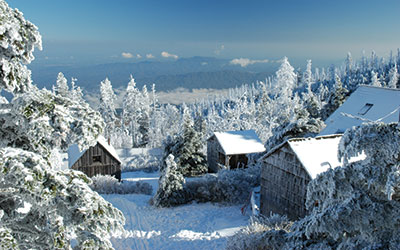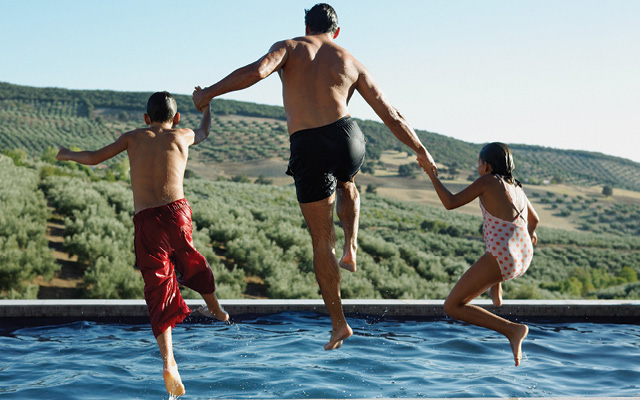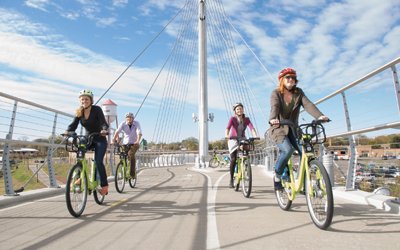Pictured above:
LeConte Lodge, Tennessee
www.lecontelodge.com
$126/adult/night, $85/child/night; includes dinner and breakfast; lunch is provided for stays of more than one night
Rain sluiced off my poncho, and trail mud caked my sneakers. In the early-April chill, the new tips of ferns in Tennessee’s Smoky Mountains were tightly curled into fiddleheads. Just 9 years old, I thought the steep, soggy, 5.5-mile slog up Mt. LeConte was the worst spring vacation ever. My brother and I whined, despite the promise of hot chocolate at our destination: LeConte Lodge, a name our father uttered covetously, the way the Spanish conquistadors whispered of El Dorado.
At last the wooden cabins appeared, like ghosts in the mist. Inside the main lodge we found a roaring fire and the much-anticipated steamy cocoa. We dined by kerosene lamp around a huge table with other hikers. There were warm wool blankets piled on the bunks in our cabin, which we shared with another family of four. The next morning, the clouds parted, and my brother and I came to understand why we’d come: Below us, the mountains stretched out endlessly, and the vista made us feel like a part of something huge.
Since the 1930s, LeConte Lodge has welcomed hikers to enjoy its rustic, backcountry hospitality. Even today there is no road, electricity, or shower. Until recently, there weren’t even flush toilets. A helicopter delivers supplies in March, and llamas bring fresh food and laundry three times a week until November.
Throughout North America, similarly remote cabins, yurts, and lodges provide escapes into nature without the drawbacks of tent camping, like heavy packs and insufficient protection from harsh weather. And in winter, hike-in and ski-in cabins enable visits to the deep wilderness with no igloo-building skills required.
Once in the backcountry, you’ll see precious few humans, but that doesn’t mean there’s little interest in these remote shelters. Many are booked months in advance, especially on weekends or holidays; a few others operate on a no-reservation, first-come-first-served basis; and some are located along continuous trails so you can hike, ski, or snowshoe from one sleeping spot to the next.
In almost every case, these backcountry sites are ideal for those seeking refuge in the wild — without the threat of wet sleeping bags.
Keep It Simple
10th Mountain Division Huts, Colorado; www.huts.org
$33/person/night
With 34 shelters and 350 miles of hiking and ski trails, Colorado’s 10th Mountain Division Hut Association boasts an array of scenic cabins equipped with the basics: wood stoves, propane burners, kitchen utensils, lighting generated by solar panels, and bunks with mattresses.
The spare huts are popular with Coloradoans like Haven Iverson, a 40-year-old book editor from Boulder. In her 20s, Iverson led backpack trips in the wilderness. Then she had children. “I thought my backcountry days were over until the kids were old enough to carry their own gear,” she says.
Fortunately, a friend told her about Eiseman Hut, a remote 10th Mountain cabin accessible only by foot or skis for most of the year. Built at 11,180 feet, Eiseman can be reached in winter only by way of two difficult seven- and eight-mile ski trails. But in late summer, when the snowpack has melted, high-clearance vehicles can usually negotiate the dirt road, which ends a quarter mile from the hut. That’s when Iverson and her friends head to the cabin for a long weekend with their young children. Vehicles transport children, food, sleeping bags, and games to the top of the road, and riders walk the rest of the way. The remaining adults either hike or mountain bike up. (Note: 10th Mountain does not guarantee vehicle access to huts; visitors are advised to prepare to hike in case of mud or snow.)
Iverson usually bikes the route. “Before the last, super-steep half-mile, I dunk my head into the spring to cool off. When we get to the hut, we all gather on the huge deck and count the mountain ranges we can see.”
Another advantage of remote shelters are the kitchens. “We cook some top-notch food and have beer and wine,” Iverson says. Other group activities include a bonfire, visits to a nearby lake for icy swims, and day hikes. “We take turns watching the kids so everybody gets uninterrupted hiking or mountain-biking time,” says Iverson.
Walls and a roof also offer peace of mind. One summer, a driver left his car windows open, and the group discovered that a bear had taken bites out of the dashboard. “Compared to regular camping, a hut trip is safer, easier, and somewhat luxurious,” Iverson points out. “Plus, it enables us to keep being outdoors, even with little kids.”
Skier’s Shangri-La
Wallowa Alpine Huts, Oregon
www.wallowahuts.com
$200-$800/person for three-to five-day stays; amenities vary per package
Every skier quests for glistening slopes of fresh, untracked snow. With that goal in mind, Pedro Tai, 62, of Parkdale, Ore., joined a ski trip into McCully Basin in eastern Oregon’s Wallowa Mountains. There, he and seven other skiers trekked to wood-stove-warmed yurts with three Wallowa Alpine Huts guides. Their sleeping quarters were spartan: sleeping bags and pillows on padded cots (clean liners and covers are provided). But to Tai, creature comforts were an afterthought; his focus was on the snow.
“The yurts positioned us for great skiing far from the crowds,” says the “gainfully retired” Tai. “And our guides found the best conditions.” For three days, he carved turns and glided over wide-open slopes above timberline. “I was in the zone, completely in the moment,” he recalls.
Before each Zen-like descent, however, was a lung-busting mountain trek. “Every inch you ski you also have to climb,” Tai explains. “We call it ‘earning your turns’ because you have to ski-in uphill — and you’re at elevation.” (The McCully yurt camp sits at 7,500 feet.) With three guides, the group was often divided by skill level. If someone was winded, one guide could escort him or her back to the yurts while the rest of the group continued their runs.
The real “luxury” of the Wallowa Alpine Huts trip was the “yurtmeisters” — experienced guides who cook all the meals, fire up the sauna yurt, and transport food up the three-mile climb to base camp. (For an extra fee, they’ll even haul in beer and wine.) They’re also certified in avalanche rescue and remote emergency care, and they teach backcountry skills.
“At my age, I’d rather save my energy for skiing, not camp chores,” Tai says. His pack — containing clothes and ski gear — weighed significantly less than what he would have carried for an independent trip. But for him, the best part was having the mountain to themselves.
“Other than our group,” Tai says, “we never saw another soul until the day we skied out and passed the next group coming in.”
Going Nowhere in Style
Skoki Lodge, Alberta, Canada; www.skoki.com
$159-$209/person/night; includes breakfast, lunch, and dinner
Melissa Rainville, 33, was used to hardy backcountry trips in the Canadian Rockies’ Banff National Park. But for an autumn getaway with two friends -— one of whom had never backpacked — she chose Skoki, a hike-in lodge with gourmet meals in the Lake Louise–area wilderness. “We were surprised to find so many amenities in the middle of nowhere,” says the Calgary marketing executive.
And “nowhere” was exactly where the trio wanted to be. “We seldom get to see each other,” says Rainville, “so being away from cell-phone service and civilization was perfect. It gave us breathing room so we could reconnect.”
Skoki Lodge, which accommodates 22 guests, has no electricity or indoor plumbing, but it’s far from uncivilized. After the friends hiked in about seven miles, carrying only clothes and toiletries, lodge caretakers welcomed them with a lunch of hearty soup. The kitchen is powered by propane gas, so cooking and baking are done fresh at the lodge.
In the evenings, the women played cards by candlelight or sipped wine and swapped wilderness stories with fellow guests before retiring to their shared room outfitted with three single beds. Rooms supply a pitcher and basin for washing up. “Walking to the outhouses was my least favorite part, but they’re close by, so it’s not a hardship,” Rainville says.
Each day, the friends trekked amid stunning teal-blue glacial lakes and larch forests where the leaves were turning gold. “I couldn’t believe how beautiful it was,” says Rainville, “or how many different hikes started right from the lodge.”
She enjoyed herself so much that she skied in with her husband a year later, and hopes to bring her mother next summer. “It’s refreshing being someplace where there’s just nature as far as you can see — but you still get to enjoy some simple comforts. Best of all, it feels like we have this piece of wilderness all to ourselves.”
Hike and Ski-In Cabins Across North America
Similar Options to 10th Division Mountain Huts:
- Alpine Club of Canada: Cabins in the mountains of Alberta and British Columbia. $34/person/night plus backcountry pass fee. www.alpineclubofcanada.ca
- Mountaineering Club of Alaska: In the Chugach and Talkeetna Mountains, unheated shelters (capacity 8–10) are free to the public on first-come-first-served basis. www.mtnclubak.org
- Mt. Tahoma Trails Association (Washington): Shelters along this 50-mile hut-to-hut trail near Mt. Rainier have sleeping pads and a fully equipped kitchen. $15/person/night. skimtta.com
Similar Options to Wallowa Alpine Huts:
- Appalachian Mountain Club: Off-the-grid cabins and lodges in Maine and New Hampshire with co-ed bunkhouses and meal service. $83–$125/person/night. www.outdoors.org
- High Sierra Camps (Yosemite National Park, Calif.): Accessible by foot or horseback, canvas tent-cabins with dorm-style beds are located 6 to 10 miles apart along a loop trail. Dinner and breakfast included: $165/person/night. www.yosemitepark.com
Similar Options to Skoki Lodge:
- LeConte Lodge (Tennessee): Five separate trails lead to private cabins and a central lodge in Great Smoky Mountains National Park. $126/person/night (includes dinner and breakfast).www.lecontelodge.com
- Phantom Ranch (Arizona): Located at the bottom of the Grand Canyon, this popular lodge is the only facility below the canyon rim. It offers dormitories ($46/person) and 4-person cabins ($149/night), with showers. Meals extra. www.grandcanyonlodges.com




This Post Has 0 Comments